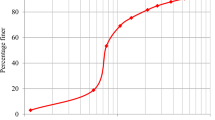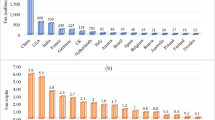Abstract
This paper studies the potential of using municipal solid waste incineration bottom ash (MSWI-BA) to produce an eco-friendly pervious concrete pavement in Lebanon, reduce landfill demand, and decrease the requirement of natural resources. The performance of a pervious concrete containing different contents of MSWI-BA, obtained from a plant in Lebanon, as a partial replacement of natural aggregate (NA) was investigated. The first stage of the research was to select appropriate mix proportions to produce pervious concrete with relatively high permeability and high strength with coarse natural aggregate particle size ranging from 2.36 to 9.5 mm. A control mix (M1) was chosen without the use of MSWI-BA. In the other mixes, the natural aggregate was replaced with 25%, 50%, 75%, and 100% MSWI-BA (by volume), having similar particle size. The effects of MSWI-BA replacement on the water permeability, compressive strength, flexural strength, ultrasonic pulse velocity (UPV), connected porosity, total porosity, and density were examined. The results demonstrated that even though there is a decrease in the permeability, strength, and connected porosity of pervious concrete, the engineering properties still meet the standard requirements for pervious concrete, indicating the possibility of producing an eco-friendly concrete with a total replacement of natural aggregate with 100% MSWI-BA.

















Similar content being viewed by others
Data availability
The authors confirm that the data supporting the findings of this study are available with the article. Any more required data are available upon request.
References
American Concrete Institute. (2010). ACI 522R-10 Report on Pervious Concrete. Farmington Hills, MI.
American Concrete Institute. Concrete Technology, ACI CT-13, 2013, pp. 78.
Tennis, P. D., Leming, M. L., & Akers, D. J. (2004). Pervious concrete pavements (No. PCA Serial No. 2828). Skokie, IL: Portland Cement Association.
Deo, O., & Neithalath, N. (2011). Compressive response of pervious concretes proportioned for desired porosities. Construction and Building Materials, 25(11), 4181–4189.
Zhong, R., & Wille, K. (2015). Material design and characterization of high performance pervious concrete. Construction and Building Materials, 98, 51–60.
El-Fadel, M., & Maalouf, A. (2020). Challenges of waste management in a developing context: Lessons from Lebanon. In Sustainable Waste Management Challenges in Developing Countries (pp. 166–185). IGI Global.
Wu, M. H., Lin, C. L., Huang, W. C., & Chen, J. W. (2016). Characteristics of pervious concrete using incineration bottom ash in place of sandstone graded material. Construction and Building Materials, 111, 618–624.
Shen, P., Zheng, H., Lu, J., & Poon, C. S. (2021). Utilization of municipal solid waste incineration bottom ash (IBA) aggregates in high-strength pervious concrete. Resources, Conservation and Recycling, 174, 105736.
Tang, C. W., Cheng, C. K., & Tsai, C. Y. (2019). Mix design and mechanical properties of high-performance pervious concrete. Materials, 12(16), 2577.
Shen, P., Lu, J. X., Zheng, H., Liu, S., & Poon, C. S. (2021). Conceptual design and performance evaluation of high strength pervious concrete. Construction and Building Materials, 269, 121342.
Lam, C. H., Ip, A. W., Barford, J. P., & McKay, G. (2010). Use of incineration MSW ash: A review. Sustainability, 2(7), 1943–1968.
Cui, X., Zhang, J., Huang, D., Liu, Z., Hou, F., Cui, S., & Wang, Z. (2017). Experimental study on the relationship between permeability and strength of pervious concrete. Journal of Materials in Civil Engineering, 29(11), 04017217.
Joshi, T., & Dave, U. (2016). Evaluation of strength, permeability and void ratio of pervious concrete with changing W/C ratio and aggregate size. International Journal of Civil Engineering and Technology, 7(4), 276–284.
Hung, V. V., Seo, S. Y., Kim, H. W., & Lee, G. C. (2021). Permeability and strength of pervious concrete according to aggregate size and blocking material. Sustainability, 13(1), 426.
Liu, H., Luo, G., Wang, L., Wang, W., Li, W., & Gong, Y. (2018). Laboratory evaluation of eco-friendly pervious concrete pavement material containing silica fume. Applied Sciences, 9(1), 73.
Chinchillas-Chinchillas, M. J., Rosas-Casarez, C. A., Arredondo-Rea, S. P., Gómez-Soberón, J. M., & Corral-Higuera, R. (2019). SEM image analysis in permeable recycled concretes with silica fume. A quantitative comparison of porosity and the ITZ. Materials, 12(13), 2201.
Borhan, T. M., & Al Karawi, R. J. (2020). Experimental investigations on polymer modified pervious concrete. Case Studies in Construction Materials, 12, e00335.
ASTM International. (2016). ASTM C33: Standard Specification for Concrete Aggregates.
Japanese Standards Association. (2016). JIS A 5371: Precast Unreinforced Concrete Products.
ASTM International. (2014). ASTM C39: Standard Test Method for Compressive Strength of Cylindrical Concrete Specimens.
ASTM C78. (2018). Standard Test Method for Flexural Strength of Concrete, PA: ASTM international.
Neithalath, N., Weiss, J., & Olek, J. (2006). Characterizing enhanced porosity concrete using electrical impedance to predict acoustic and hydraulic performance. Cement and Concrete Research, 36(11), 2074–2085.
ASTM International. (2012). ASTM C1754: Standard Test Method for Density and Void Content of Hardened Pervious Concrete.
Abdulmatin, A., Tangchirapat, W., & Jaturapitakkul, C. (2018). An investigation of bottom ash as a pozzolanic material. Construction and Building Materials, 186, 155–162.
Shen, P., Zheng, H., Xuan, D., Lu, J. X., & Poon, C. S. (2020). Feasible use of municipal solid waste incineration bottom ash in ultra-high performance concrete. Cement and Concrete Composites, 114, 103814.
Tijani, M. A., Ajagbe, W. O., Ganiyu, A. A., & Agbede, O. A. (2019). Effect of aggregate type on properties of pervious concrete. Journal of Modern Technology and Engineering, 4(1), 37–46.
Chen, Y., Wang, K., Wang, X., & Zhou, W. (2013). Strength, fracture and fatigue of pervious concrete. Construction and Building Materials, 42, 97–104.
Chen, X., Wang, H., Najm, H., Venkiteela, G., & Hencken, J. (2019). Evaluating engineering properties and environmental impact of pervious concrete with fly ash and slag. Journal of cleaner production, 237, 117714.
Maguesvari, M. U., & Narasimha, V. L. (2013). Studies on characterization of pervious concrete for pavement applications. Procedia-Social and Behavioral Sciences, 104, 198–207.
Ghanem, H., Khatib, J., & Elkordi, A. (2020). Effect of partial replacement of sand by mswi-ba on the properties of mortar. BAU Journal-Science and Technology, 1(2), 4.
Sandoval, G. F., Galobardes, I., Schwantes-Cezario, N., Campos, A., & Toralles, B. M. (2019). Correlation between permeability and porosity for pervious concrete (PC). Dyna, 86(209), 151–159.
Lo, F. C., Lo, S. L., & Lee, M. G. (2020). Effect of partially replacing ordinary Portland cement with municipal solid waste incinerator ashes and rice husk ashes on pervious concrete quality. Environmental Science and Pollution Research, 27, 23742–23760.
Li, L. G., Feng, J. J., Zhu, J., Chu, S. H., & Kwan, A. K. H. (2021). Pervious concrete: Effects of porosity on permeability and strength. Magazine of Concrete Research, 73(2), 69–79.
Deo, O., & Neithalath, N. (2010). Compressive behavior of pervious concretes and a quantification of the influence of random pore structure features. Materials Science and Engineering: A, 528(1), 402–412.
Lian, C., Zhuge, Y., & Beecham, S. (2011). The relationship between porosity and strength for porous concrete. Construction and Building Materials, 25(11), 4294–4298.
Acknowledgements
The authors of this study acknowledge the support of the SICOMO incineration plant for providing the required MSWI-BA.
Author information
Authors and Affiliations
Corresponding authors
Ethics declarations
Conflict of Interest
The authors declare that they have no conflict of interest.
Rights and permissions
Springer Nature or its licensor (e.g. a society or other partner) holds exclusive rights to this article under a publishing agreement with the author(s) or other rightsholder(s); author self-archiving of the accepted manuscript version of this article is solely governed by the terms of such publishing agreement and applicable law.
About this article
Cite this article
Nasser Eddine, Z., Khatib, J., El Kordi, A. et al. Performance of a Pervious Concrete Pavement Containing Municipal Solid Waste Incineration Bottom Ash: A Lebanese Case Study. Int. J. Pavement Res. Technol. (2023). https://doi.org/10.1007/s42947-023-00320-z
Received:
Revised:
Accepted:
Published:
DOI: https://doi.org/10.1007/s42947-023-00320-z




